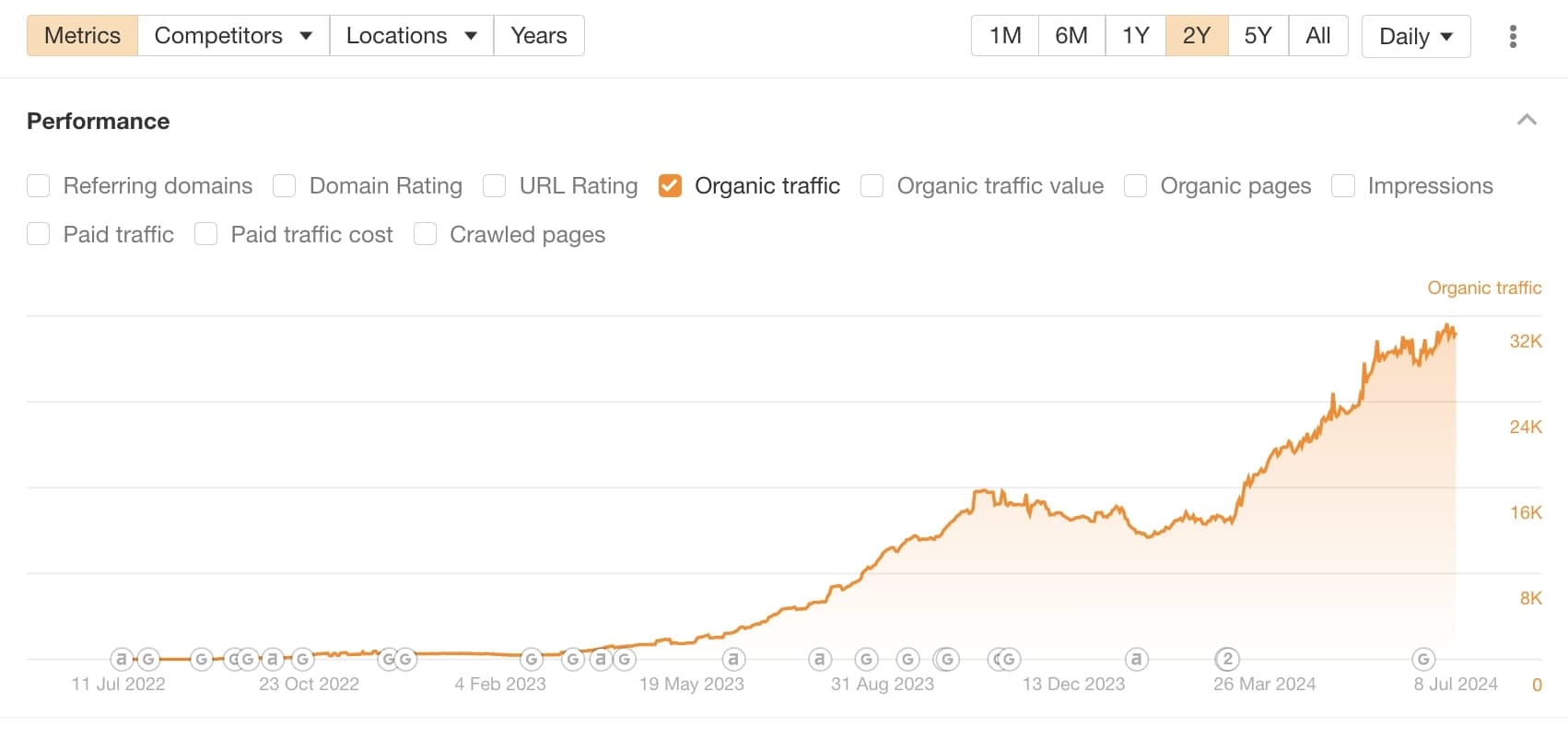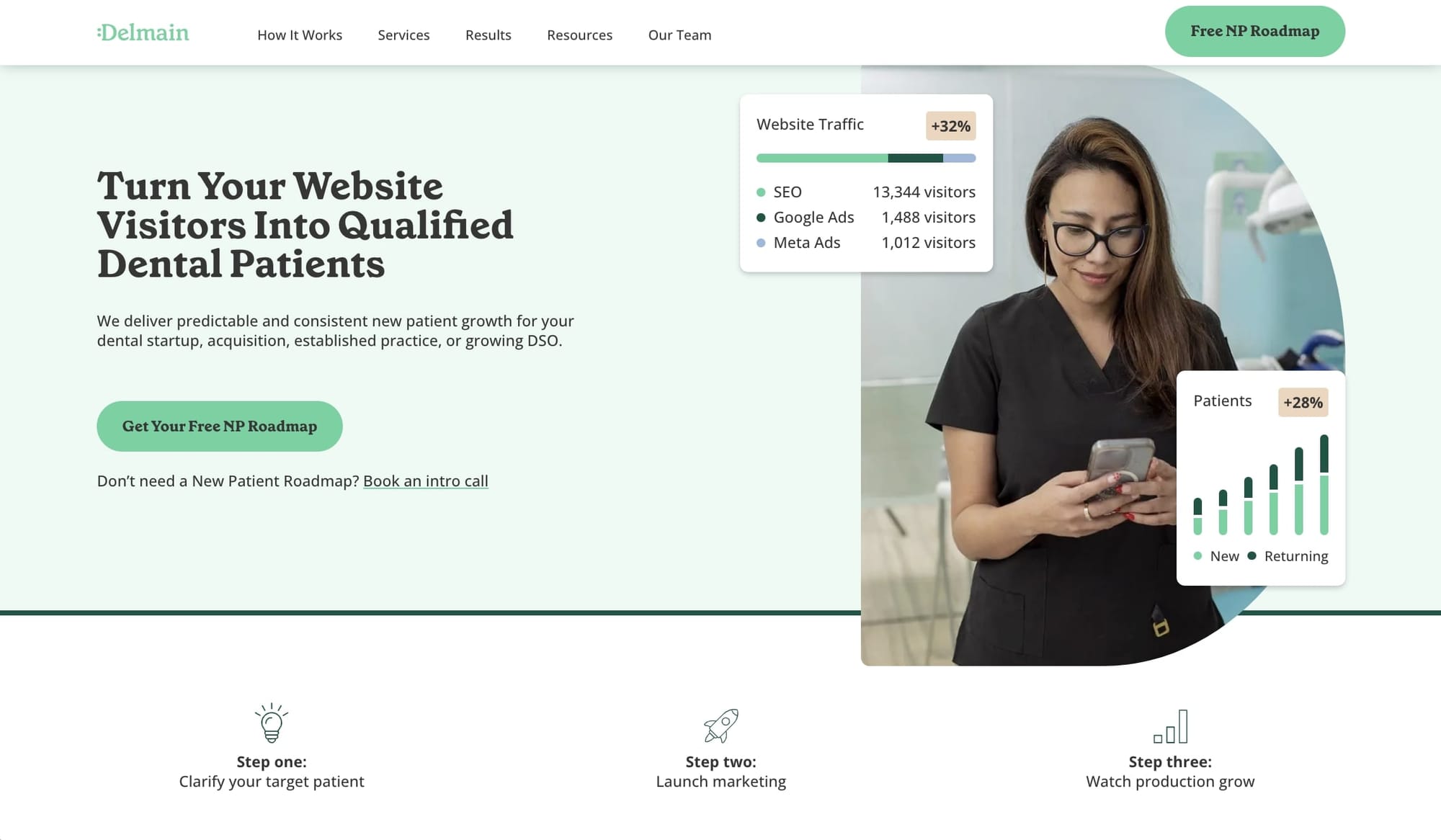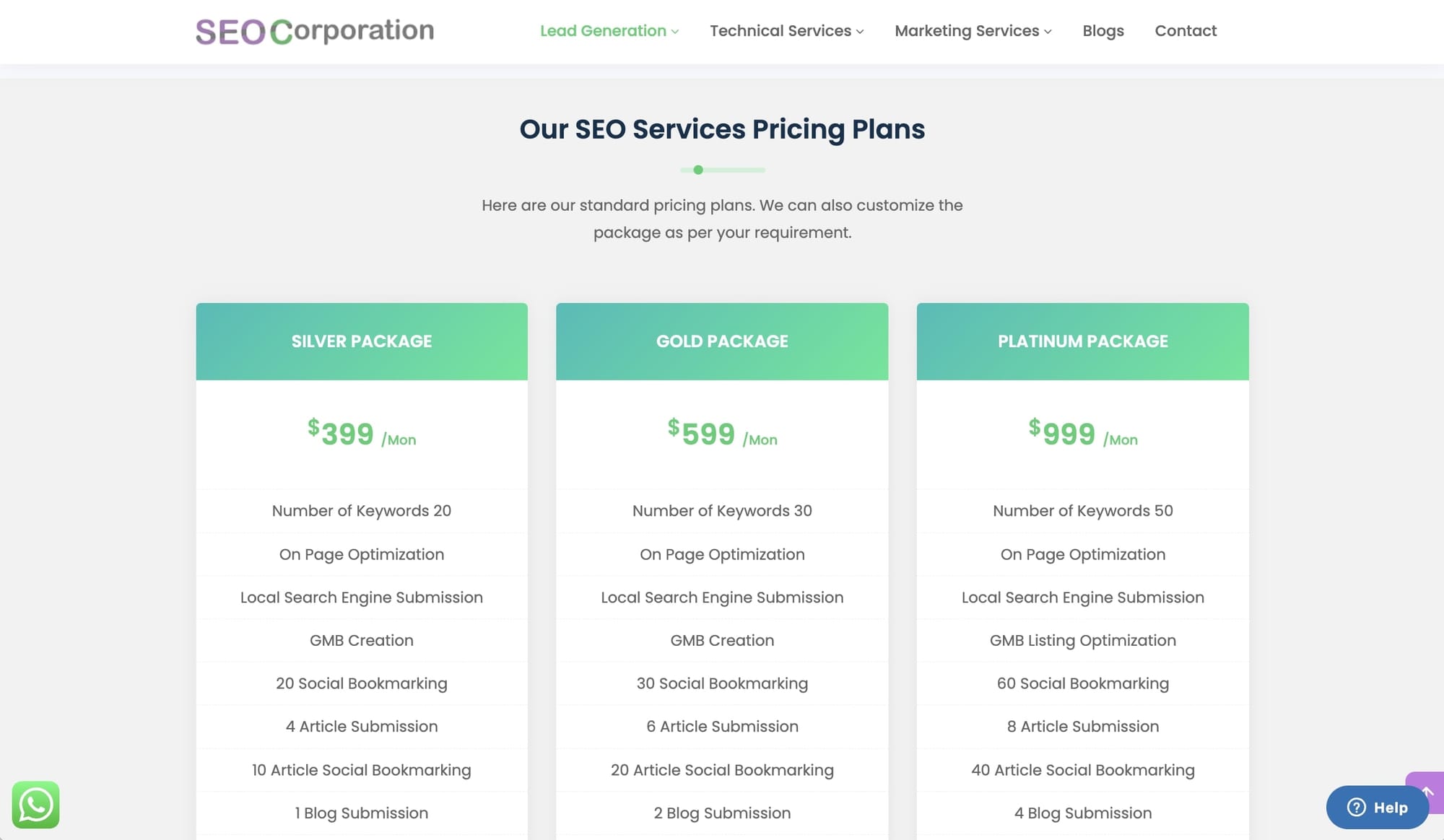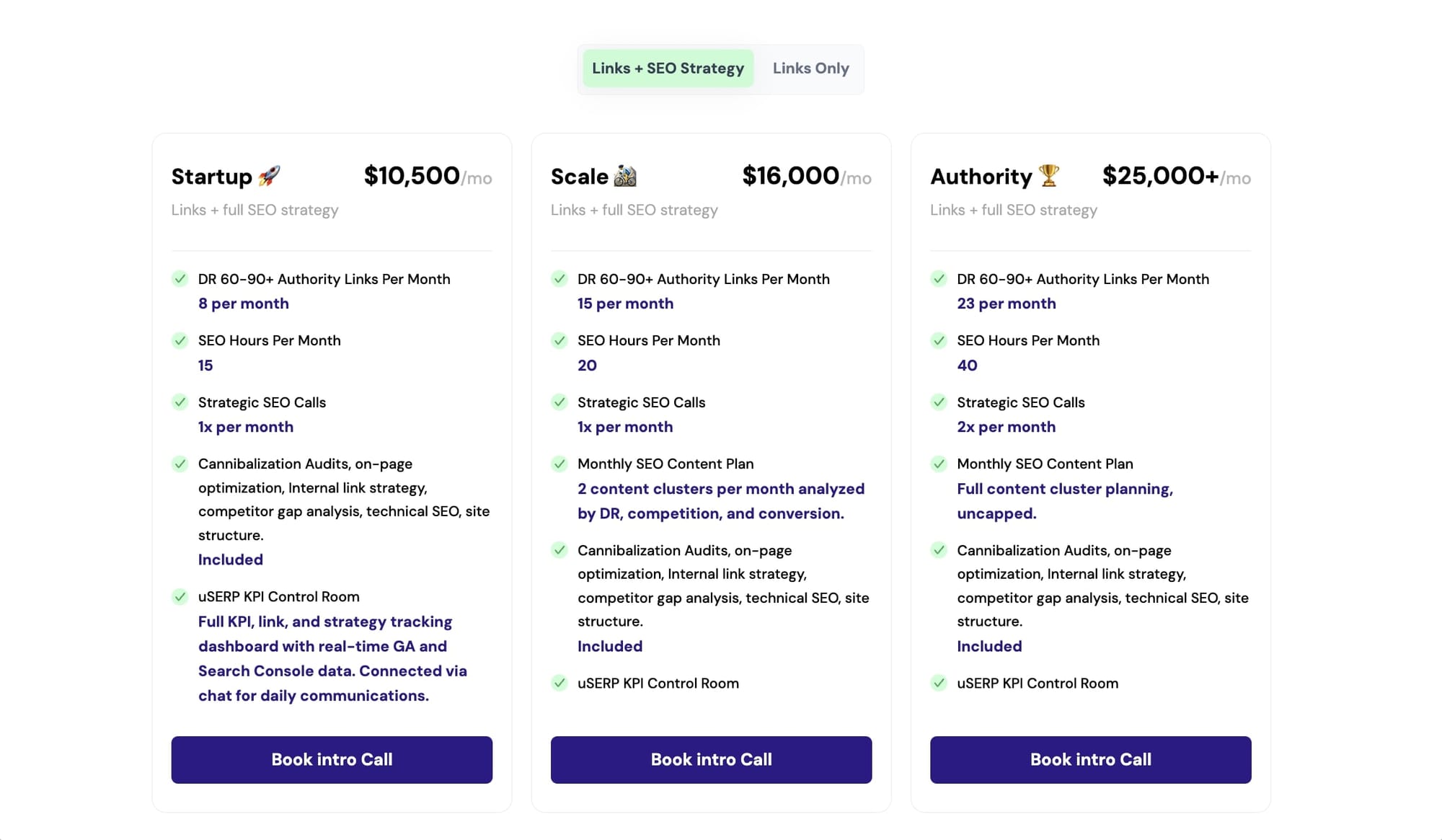
I wanted to write this SEO services pricing guide for the younger version of myself. The person who just quit his job leading SEO at a tech company in San Francisco to venture out into the world of SEO freelancing.
This is the article I wish I had when I started.
My first year of freelancing was pretty brutal. I was charging clients $2K per project and I didn’t have the best business model.
Many of these projects consisted of me acting as a consultant and telling clients what to do. And when they didn’t execute on the work properly, no results happened.
It wasn’t until a year later that I found myself closing $10K per month deals with software companies and being able actually to execute on the work. And, to this day, the clients whom I’ve been able to execute on all have seen an increase in traffic and conversions:

It was a long way coming trying to figure out my pricing. I’ve experienced everything from being lowballed to throwing out a crazy number to a potential client and having them say “yes” without hesitation.
So, in this article, I want to give you a full guide on SEO pricing. We’ll go over how much SEO services cost based on industries and project types, I’ll show my 5 step plan for creating your own pricing strategy, and I’ll go over how to charge your clients so you can accept payments easily.
Alright, let’s get started.
How much do SEO services cost?
The cost of SEO services depends on factors such as your business model, location, types of clients you work with, your expertise, and the depth of your SEO campaigns.
According to Ahrefs, on the lower end, you can find SEO freelancers charging less than $50 per hour of work. And on the higher end, you can find SEO agencies charging over $20K per month retainers (I’ve worked with agencies that charge this much).
It all really depends on if you’re billing hourly, monthly, or performance-based. I’ll get more into these in the next section. But for now, know that the cost of SEO services has a broad range.
I’ll tell you a personal story: When I first moved to New York City, I had no friends. In an effort to connect with people, I joined a small group that went for “walks and talks” in the city. At one point, I met someone in this group and we started talking about work and what we do for a living. He told me he worked in SEO, and my face lit up (because I was at the peak of my SEO freelancing career).
I asked him what he does and he said he just joined an agency, but before that he was freelancing. I asked why he stopped freelancing and he said it was because he wasn’t making enough money to pay for his bills. I asked how much he was making from freelancing and he said roughly $3K per month. I understood why he went to work at an agency for better pay.
But, I was making $27K per month from SEO freelancing. I didn’t tell him at the time because I felt it wasn’t appropriate — even though I’m waiting about it now. However, that experience made me realize that the range of how much SEO services cost can be super broad.
It made me question: what’s the difference between someone struggling to pay bills and someone who is living quite well?
And I realized my approach has always been this: fewer clients, but high-ticketer per client. Note that I am also able to do this because I’ve worked in this industry for a long time and have a portfolio of case studies I can show.
I also only go after a specific type of client to be able to make this much, and I’ll explain everything in the next section.
How to price your SEO services in 5 steps
Knowing how to properly price your SEO services can be the difference between making a small side income and running a lucrative business.
In this section, I’ll talk about my approach to figuring out how much you should charge for your services. Step one is the most crucial.
Here’s my 5 step approach to pricing SEO services:
- Know your niche
- Research your competitors
- Decide on a business model
- Productize your services
- Be flexible
Alright, let’s dive deeper into each section.
1. Know your niche (who and what)
The biggest thing in business is knowing who you’re selling to and what you’re selling. You literally have these two levers that you can experiment with. Some combinations can yield a small income, while others can become a full-time job.
Let’s talk about who you’re talking to.
This part is all about your target clients. Smaller businesses looking for local SEO services have different needs from a billion-dollar tech company looking to ship hundreds of blog posts.
And when I talk about knowing your niche, what I really mean is finding a sub-niche within a broader niche.
If your niche is local SEO, you want to become an expert in a specific type of client that needs local SEO services. You want to find a sub-niche in this category, be it helping lawyers, dentists, accountants, or other professionals who sell services locally.
For example, Delmain is a marketing agency designed specifically for dentists. And one of the services they sell is SEO.

If you can become the go-to person as it pertains to dental SEO, and do a good job of getting your clients a lot of customers, your services will spread by word of mouth. Dentists will mention that they’re working with you to their peers and those people will also get curious and want to hear about what you can do for them.
So, knowing who you’re targeting is important. And, ideally, you focus on one type of customer and nail it down before you branch out (if you ever decide you want to).
On the other end, you also need to know what you’re selling.
We’ll talk more about this in step four, but what you're selling is the value proposition of your service. Are you selling local SEO services? Are you selling SEO content creation services? Are you selling programmatic SEO services?
The “what” of what you’re selling also depends on what your target audience values most. If your target audience is B2B SaaS companies (like mine is), then you’ll notice that many of these companies want content creation services.
It’s sort of like an equation you have to get right. Not every pair of who + what is going to yield success. Here’s a visual representation:
- Dentist + local SEO services = success
- Dentist + content creation services = unknown
- B2B SaaS + content creation services = success
- B2B SaaS + local SEO = unknown
If you’re not sure what type of services your target audience needs, you can figure this out by doing some competitive research. So, let’s dive into the next section.
2. Research your competitors
This part of the process is going to help you with two things: helping you figure out the types of services you should offer and figuring out the price.
It’s common to associate the word “competitor” with something negative. But, in fact, competitors are a sign of life. It’s a sign that SEO services are wanted and if you have a handful of competitors in the niche you want to dive into, it’s a great sign that there’s money to be made.
So, embrace your competitors.
For this section, you really have to nail down the first part of this process we went over. Without knowing who you’re selling to, you won’t really know what to look for when researching. Let’s walk through a couple of examples.
Say the target audience is dentists, and we want to help them get more clients in their area. With just this knowledge, we can begin to Google search “dentist SEO services”.
But to make things even better, because not many agencies display their pricing publicly, we can do a more advanced Google search.
We can search dental seo services + "pricing plans". This will then show results that have the text “pricing plans” somewhere on their landing page. This is a good indicator that a company has their pricing publicly available.
In this case, we can see this company selling dental SEO services:

They show everything they offer in their packages as well. This is a lot of good information for us to take into consideration. Of course, we don’t want to copy this business exactly. But it does give us a benchmark for what’s currently out there.
We want to keep doing this until we have a handful of different options and can compare all of them. Here’s another example:

Try to look at what these packages offer and for what price. You may be able to charge more if you can offer better value in your packages.
This way of doing competitor research can help guide you in what you should offer and at what price. But again, you don’t want to just blindly copy these. You want to create your own packages and pricing based on the value you know you can bring.
3. Decide on a business model
The next step is to decide on a business model. Here are four popular ones SEO professionals use:
- Hourly pricing
- Monthly subscription pricing
- Project-based pricing
- Performance-based pricing
I’ve experimented with all four and here’s how I would rank them in order from my least favorite to most favorite: hourly → project-based → performance-based → monthly subscription.
This flow also reflects the phases I’ve gone through as a freelancer. I started hourly, and today I bill a combination of monthly and performance-based — performance means getting paid per lead that you drive for a business (think affiliate marketing).
Hourly is great for beginners, and you can go on freelancing sites like Upwork to see what people are charging for their hourly rate. You can also sign up to Upwork and start to get your first clients through their platform.
But the downside with hourly is that, as you get good at your job, you almost get punished for being more efficient. When I first started doing SEO, the same task that took me eight hours to complete now takes me three hours. That’s five fewer hours of pay if I bill hourly, even though the end result is the exact same (if anything the end result is better with the three hours because of the extra years of experience).
SEO is one of those marketing skills that does not correlate well with the time you put in. It’s all about driving business value, regardless of how long it takes you. This is why hourly is not my favorite (but many smaller businesses love it, so it’s a good way to get your foot in the door and build your portfolio of work).
Next is project-based pricing. This is charging a one-time fee for a set amount of work. For example, I used to create SEO consulting packages for clients. I would tell them exactly what to do over one quarter to a year and package everything nicely. They would then “purchase” this package and it was up to them to execute on it.
This was nice because I could create templates for how I approached everything and replicate my workflow across any client I worked with — minus the tailored research it took for each individual website.
But then, I stopped doing this for two reasons:
- I couldn’t control the end results (this was mainly due to my consulting model).
- I constantly had to figure out how I was going to get my next project.
The latter is what started to burn me out. Having to do all the work, while also having to think two steps ahead on where my next client project was coming from, was too much.
And then, while doing competitor research, I came across a few agencies selling similar services (and to the same audience), and all of them had monthly retainers with their clients. So, I went out and created packages for my services and I charged a monthly subscription. And to have an edge against other larger SEO agencies, I told potential clients that everything was month to month — they didn’t have to lock themselves into an extended contract.
Then, magic started to happen. And I actually ended up retaining my clients for many months and years. In fact, any client I’ve stopped working with since I switched to this model was because of a decision I made.
I came to realize that the service business model, especially as a freelancer, is best when you can retain the same client roster and bill them monthly. To do this, you need to create a clear value proposition by productizing your services. And this leads us nicely into the next section.
4. Productize your services (service packages)
This part of figuring out your SEO service pricing is about packaging things in a way that makes your services feel more like a product.
If you do this part right, you’ll not only make things more efficient for yourself but you’ll also be able to convey your services clearly to potential clients.
I wrote another guide on how to productize your services. But in this article, I’ll give you some examples you can follow.
If we actually look back to the examples I showed in step two, we can see that both of the dental SEO agencies had productized their services — they had clear pricing plans with different tiers of services in each one.
Combine this with a monthly subscription business model, and your service business will feel more like a SaaS company — which is great for predicting your revenue for the long term.
For example, uSERP is a link-building SEO agency that has productized its services:

Each pricing plan clearly shows what the client is paying for. This way, there’s no confusion on what uSERP will deliver and they eliminate the risk of scope creep.
Outside of just SEO services, there are tons of other marketing and design agencies that have productized their services. My own services are also productized and it’s how I’ve been able to freelance for such a long time with a relatively small client roster.
5. Be flexible
The last part of this process is to be flexible. When selling services, you want to understand what your potential clients are looking for. I say this because I’ve run into situations where I was so focused on my packages that I was unwilling to be flexible with my pricing and services.
On one end, this is protecting my own time and workflow. But also, I’ve lost the opportunity to work with some cool companies because other service providers were more willing to be flexible.
So while productizing your services is great for scaling your own operations internally, I think you also need a healthy dose of flexibility if you want to build the best SEO business.
Business has a lot of nuances, and different types of customers demand different types of services. So be careful not to get too pigeonholed in your day-to-day tasks and operations. After all, if you’re not having fun running your business, what’s the point?
How to charge for SEO services
Are you ready to start charging clients for your SEO services? Hold up, I’m not going to pitch you on anything yet.
But what I do want to hit home here is that building a successful SEO business is more than just pricing your services. It’s also about sending contracts, creating a great client experience, knowing how to bill clients, and also keeping your finances and expenses in check.
So once you have your pricing down, it’s time to figure out how you’re going to charge for your services and get paid. This is where a client portal platform like Copilot comes in handy.
Copilot is an all-in-one solution for running your service business. Everything from creating white-label client portals, to messaging, to client management, to file storage, contracts, billing, reporting, and much more can be done in Copilot.
Copilot was also built to be an extensible platform. So if you’re already using other tools in your agency tech stack, you can easily integrate those into Copilot as well. This way, you can embed SEO dashboards or project management solutions like ClickUp to give your clients visibility into everything they’re doing.
But before you sign up for a free 14-day trial of Copilot, I highly recommend playing around with the demo portal. If you like it, try it out for your own SEO business (no credit card required).
Happy SEOing!
Share this post
Sign up for our newsletter
Subscribe to our newsletter to receive emails about important announcements, product updates, and guides relevant to your industry.
